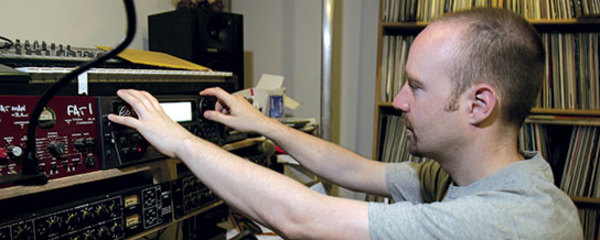Mr. Scruff in the Studio
Compared to the standard dark breaks and moody electronic music we’re used to, Andy Carthy’s […]
Mr. Scruff in the Studio
Compared to the standard dark breaks and moody electronic music we’re used to, Andy Carthy’s […]

Compared to the standard dark breaks and moody electronic music we’re used to, Andy Carthy’s deft work behind the 1200s and painstakingly composed beats sound downright happy. On such humorously titled albums as Trouser Jazz, the artist known as Mr. Scruff pens odes to dancing and sausages. Amidst the rigors of touring, he’s been working on a slew of remixes and preparing for a sequel to 2004’s DJ mix Keep it Solid Steel. After a whirlwind week of DJ gigs ringing in the New Year, Scruff finally got a chance to relax, sip a cup of tea, and sit down for a chat about what makes his studio tick.
XLR8R: What are the most indispensable pieces of equipment in your studio?
Andy Carthy: A tea kettle, an [Akai] MPC 60, and the E-mu 6400 sampler. I have a very small studio, and along with that I use the [E-mu] SP-1200. They’re both very old pieces of equipment from about 1987. They’re both mono. The quality of the sampling on the SP and the MPC is quite low, so any sample you put in there comes out the other end with the sound of that machine. The MPC has a bit more memory, it’s a bit more versatile, and the SP is very brutal, very gritty, and it has a great rock solid feel, even though when you analyze it the groove is actually quite wobbly. [The limited sampling rates] help me create a style rather than wallowing around in a laptop that’s got unlimited everything and 2,000 plug-ins and every keyboard ever made. I prefer to acquaint myself with two or three bits of equipment that are quite limiting, and just push those and that limit.
Do you have keyboards in your setup?
Well, I only have one keyboard. It’s a Korg MS 2000, not the original ‘70s one but a repro. With my keyboard sounds especially, I will resample stuff and then quite heavily process it in the sampler, or just resample lines that I played live, just to give it a similar feel to the sampled record. Or just to grime it, [I’ll] put it through old compressors or EQs, just to give it that warmth, that feel of the music from the ‘60s and ‘70s, that grainy sound quality. It gives it a coat, a slight ambiguity that’s difficult to explain but easy to hear.
And you wire your studio differently for each track?
The reason for the different wiring has to do with different machines being in control. If I’m using two or three samplers, then one will be sending the MIDI and handling the sequencing and the others will be following it, depending on whether the main groove is created in the Mac, the MPC, or the SP.
How do you get started making a track?
I don’t tend to have a theme or anything when I work on my albums, I just write music and a theme or mood reveals itself. Remixes are quite nice because you already have some definite material to work with and some restrictions, and I generally only remix stuff I already like. I just approach each piece of music individually and try and find out what it’s telling me. It’s like a conversation between you and the piece of music you’re writing, and it’s definitely not a one-sided conversation. Every instrument in a record has a voice–whether it’s drums, bass, vocals, keys, horns, or random effects, it’s all part of a song. As long as something has the requisite amount of light, shade, and contrast then you will find it engaging, the same way you mix ingredients and put a bit of seasoning in your food.

